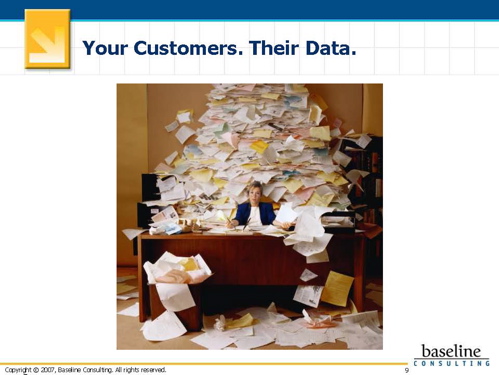 I’m cleaning my house this morning and I’m really irritated. What is all of this direct mail CRAP doing everywhere?
I’m cleaning my house this morning and I’m really irritated. What is all of this direct mail CRAP doing everywhere?
I don’t want infinite investor minutea on every fund offered by every financial company I do business with. I don’t want spring, summer, fall, and winter mini-catalogs from companies I only purchase from at Christmastime. I don’t want business solicitations from companies I already do business with.
Want to green the planet and save money at the same time? Stop sending irrelevant junk! I’m not talking about purchasing prospect lists and launching into new territory. I’m talking about irresponsible direct mail behavior with the databases and customers you already have. I’ve written about this before from a smart marketing and smart greening perspective. Now I’m writing from a perspective perspective.
Good brief, corporate America. Clean up your databases. Use some basic personalization to send only information relevant to your customers. (Just send me information on MY funds — not the other 563 funds I don’t invest in!) Centralize your customer and marketing databases so you know who your customers are and don’t waste money, trees, and fossil fuels marketing basic services to them.
What volume of carbon emissions could we save if we just cut out all the unnecessary clutter? But the fact is, we produce plumes of greenhouse cases, gulp endless amounts of fossil fuel, and churn up the paper fibers just to deliver unnecessary and irritating mail to millions of people who hate it.
So . . . improve your bottom line. Start targeting and personalizing, at least on a basic level, and do the planet — and me — a huge favor.



You can also opt-out of 75% of direct marketing mail. Just go to the DMA website to opt out: http://www.dmachoice.org/.
You can also opt-out of 75% of direct marketing mail. Just go to the DMA website to opt out: http://www.dmachoice.org/.
Yes, it’s important for people to opt out of unsolicited direct mail. But I’m not talking about these kinds of lists. I’m talking about companies I already do business with — companies that have a right to send me mail, companies I want mail from, but which send massive volumes of unnecessary mail. I want mail from the financial company that handles my IRA. What I don’t want is volumes of pages of information on retirement plans I don’t own. I want catalogs from A, B, and C company, but they know I don’t purchase in the spring, summer, or fall — I haven’t for the 10 years I’ve purchased from these catalog companies — so continuing to send me catalogs in these seasons is unnecessary and irresponsible from an environmental point of view. “Opt out” lists don’t address this problem.
Yes, it’s important for people to opt out of unsolicited direct mail. But I’m not talking about these kinds of lists. I’m talking about companies I already do business with — companies that have a right to send me mail, companies I want mail from, but which send massive volumes of unnecessary mail. I want mail from the financial company that handles my IRA. What I don’t want is volumes of pages of information on retirement plans I don’t own. I want catalogs from A, B, and C company, but they know I don’t purchase in the spring, summer, or fall — I haven’t for the 10 years I’ve purchased from these catalog companies — so continuing to send me catalogs in these seasons is unnecessary and irresponsible from an environmental point of view. “Opt out” lists don’t address this problem.
I can only imagine too that these companies would see greater return on their direct-mail initiatives if they did target more. It would take a lot of time and effort in planning their attack (so to speak) than just sending everybody the same thing. They would also lose out on volume discounts for printing mass amounts of the same brochure, flyer, postcard, etc., but if the recipients see it’s not just another “junk” mail piece, I believe they would be more intrigued to read it versus getting tossed straight in the recycling.
I can only imagine too that these companies would see greater return on their direct-mail initiatives if they did target more. It would take a lot of time and effort in planning their attack (so to speak) than just sending everybody the same thing. They would also lose out on volume discounts for printing mass amounts of the same brochure, flyer, postcard, etc., but if the recipients see it’s not just another “junk” mail piece, I believe they would be more intrigued to read it versus getting tossed straight in the recycling.
Personalizing actually isn’t as complicated as many people think. I encourage marketers to have some basic exploratory conversations with good marketing firms like DIG Creative or Trekk Cross-Media. As as for volume discounts, you only lose those if you reduce the volume of the mailing drastically. If all you do is reduce the number of pages in each communication so that those communications are personalized and relevant, then you’re still mailing to the same number of people — so the discounts are the same. Discounts are based on the volume of pieces, not the number of pages mailed.
Personalizing actually isn’t as complicated as many people think. I encourage marketers to have some basic exploratory conversations with good marketing firms like DIG Creative or Trekk Cross-Media. As as for volume discounts, you only lose those if you reduce the volume of the mailing drastically. If all you do is reduce the number of pages in each communication so that those communications are personalized and relevant, then you’re still mailing to the same number of people — so the discounts are the same. Discounts are based on the volume of pieces, not the number of pages mailed.
I was meaning you may lose out on the volume discounts on the printing side. Say for instance, instead of printing 10K identical pieces for 10K clients, if you target the printing to be more specific to different groups like 2500 each of 4 different “types” of customers, you’d only received the 2500 break versus the 10K break on printing. But right, your mailing cost would still be the same.
I was meaning you may lose out on the volume discounts on the printing side. Say for instance, instead of printing 10K identical pieces for 10K clients, if you target the printing to be more specific to different groups like 2500 each of 4 different “types” of customers, you’d only received the 2500 break versus the 10K break on printing. But right, your mailing cost would still be the same.
I’m looking for stats on the percentage of those cheesy/generic nature calendars mailed out by variuos corporations every year end up in the trash. Generally, I toss out any I get and I believe that most others suffer the same fate as the ones that arrive in my mailbox. The poblem is the company I work for produces them too and I can’t get it stopped unless I have hard numbers.
Can anyone help…has anyone read anything on the subject?
I’m looking for stats on the percentage of those cheesy/generic nature calendars mailed out by variuos corporations every year end up in the trash. Generally, I toss out any I get and I believe that most others suffer the same fate as the ones that arrive in my mailbox. The poblem is the company I work for produces them too and I can’t get it stopped unless I have hard numbers.
Can anyone help…has anyone read anything on the subject?